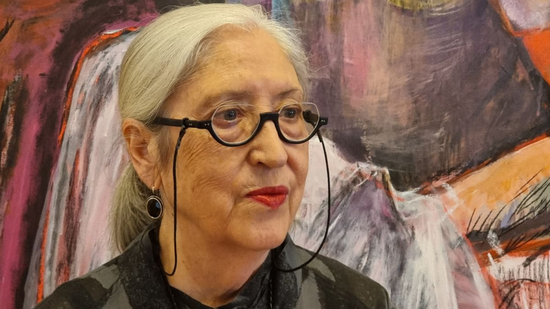
7 facts about Graça Morais
Wrapped in mystery and surprise, Graça Morais (1948) creates works that convey to the viewer his memory of the rural world, of the village of Vieiro in Trás-os-Montes, where he was born and raised. In a relationship between the body, thought and experience, the artist paints with strong strokes the faces of a village, the stories of the Portuguese people, their customs, the way of working and the power of motherhood. In addition to painting, he created illustrations for books and tile panels in various buildings such as the Caixa Geral de Depósitos Building in Lisbon, the Belarusian Metro Station in Moscow, among others. Graça Morais represented Portugal at the XVII Bienal de São Paulo in 1983. Find out more about the artist here.
1.Graça Morais is the biggest collector of his paintings.
Maria da Graça Pinto de Almeida Morais was born in Freixiel, Vila Flor, on March 17, 1948. She lived in Mozambique between 1957 and 1958, returning to Vieiro the following year. In 1966, he entered the Escola Superior de Belas Artes do Porto to study painting, having completed the course in 1971 and presented the 5th year evaluation exhibition at the Escola Superior de Belas Artes do Porto. In 1974, he exhibited for the first time at the Alberto Sampaio Museum, in Guimarães. She currently lives and works between the city of Lisbon and the village of Vieiro, with her partner, the guitarist Pedro Caldeira Cabral, and says she finds it very difficult to separate herself from her work, which is why she is probably the greatest collector of her works. pictures.

2. The paintings and drawings of Graça Morais are populated by female figures.
Her paintings and drawings are populated by female figures who tell the artist's own story but also weave mythical and tragic choreographies of the secrets of working women from a generation before her own. In recent years, he has become increasingly involved with human violence, portraying “a transfigured world” full of war and other problems.
3. He left Lisbon, in 1981, to live and work in the village of Vieiro.
The forms and materials of the Northeast of Trás-os-Montes, that is, the expression of its roots, are the target of intense reflection, where it remains for two years, although it continues to exhibit. In 1982, he made several visits (to Westkunst, in Cologne, to Documenta in Kassem, in Vienna). Create a series of dog drawings.

4. He divides his time between the studios in Lisbon and Vieiro-Freixiel, the village in the north of Portugal where he was born.
As the olive tree is linked to the national territory, Graça Morais is immensely immersed in the Portuguese rural atmosphere and mythology, more specifically in Trás-os-Montes, in the extreme northeast of Portugal. He divides his time between his studios in Lisbon and Vieiro-Freixiel, the village in the north of Portugal where he was born in 1948. This is where he nurtured the ideas and images that we see represented in his works, from dogs, cats and goats, to the violence of men and the cruelty of nature. Raw and natural, Graça Morais expresses the other side of its origins, thus making known the human being, its abilities and stories. Daily life is the main theme in the artist's work, so it became essential to represent the activities of the people around her, from recording clothes, to hair, passing through the very relationship that individuals have with the earth. Graça Morais compares an artist's act of creation with the affection that people have for the earth and for creating something in it that will later bear fruit.
5.The life and work of Graça Morais were the subject of documentaries.
The life and work of Graça Morais were the subject of the documentaries As Escolhidas (1997), by Margarida Gil, In the Head of a Woman is the Story of a Village (1999), by Joana Morais, and Graça Morais and the Writers (2017), by Luís Alves de Matos. In 2011, Joana Providência choreographed Terra Quente Terra Fria, created from the painter's work. In 2015, Teatro da Garagem premiered the play Graça: Suite Teatral em Três Movimentos, based on texts by Graça Morais and António Tabucchi, staged by Carlos J. Pessoa.

6.Graça Morais I give Bragança 70 works worth half a million euros
Graça Morais was the first to offer 52 paintings, to which it now adds another 70, worth half a million euros, as the painter advanced to Lusa. The painter explained that the donation includes “works from different stages” of her career and added that next year she intends to “make a larger donation. Because I think I have this obligation to leave an important legacy here in the region where I was born and in my country”, he declared.
7.In 2008, the Contemporary Art Center was inaugurated Graça Morais (CACGM)
Graça Morais was invited by the Câmara de Bragança, the owner of the Centro de Arte Contemporânea, to be the mentor of this space opened in 2008. The cultural equipment is installed in a historic building, in the center of Bragança, refurbished by the architect Souto de Moura, and has become a space that gives access, in this region, to art previously only accessible in the big cities. Since that year, the Contemporary Art Center Graça Morais has permanently and continuously presented several exhibitions by the artist, curated by its director Jorge da Costa. The Center always has an exhibition of Graça Morais simultaneously with that of another artist, and promotes activities, namely with the younger ones, to awaken them to the arts.

